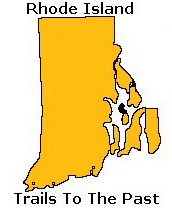|
History of Rhode Island
Source: Wikipedia
In 1636, Roger Williams, after being banished from the Massachusetts Bay Colony for his religious views, settled at the tip of Narragansett Bay, on land granted to him by the Narragansett and Pequot tribes. He called the site Providence and declared it a place of religious freedom. Detractors of Williams' ideas sometimes referred to it as Rogue's Island.
In 1638, after conferring with Williams, Anne Hutchinson, William Coddington, John Clarke, Philip Sherman, and other religious dissidents settled on Aquidneck Island (then known as Rhode Island), which was purchased from the local natives, who called it Pocasset. This settlement was called Portsmouth was governed by the Portsmouth Compact. The southern part of the island became the separate settlement of Newport after disagreements among the founders.
Samuel Gorton purchased the Native American lands at Shawomet in 1642, precipitating a military dispute with the Massachusetts Bay Colony. In 1644, Providence, Portsmouth, and Newport united for their common independence as the Colony of Rhode Island and Providence Plantations, governed by an elected council and "president". Gorton received a separate charter for his settlement in 1648, which he named Warwick after his patron.
During King Philip's War (1675-1676), a force of Massachusetts, Connecticut and Plymouth militia under General Josiah Winslow invaded and destroyed the fortified Narragansett Indian village in the Great Swamp in what is now South Kingstown, Rhode Island, on December 19, 1675. The Narragansett also invaded and burnt down several of the cities of Rhode Island, including Providence, although they allowed the population to leave first. In one of the final actions of the war, troops from Connecticut hunted down and killed Wampanoag war leader Metacomet, who the colonists called "King Philip", in Rhode Island.
The colony was amalgamated into the Dominion of New England in 1686, as King James II attempted to enforce royal authority over the autonomous colonies in British North America. After the Glorious Revolution of 1688, the colony regained its independence under the Royal Charter. Slaves were introduced at this time, although there is no record of any law legalizing slave-holding, although the colony later prospered under the slave trade, by distilling rum to sell in Africa as part of a profitable triangular trade in slaves and sugar with the Caribbean.
"King Philip's Seat", a Native American meeting place on Mount Hope
Rhode Island's tradition of independence and dissent gave it a prominent role in the American Revolution. Approximately at 2 AM on June 10, 1772, a band of Providence residents attacked and subsequently burned to the waterline, the grounded HMS Gaspee, for harassing shipping within Narragansett Bay. Rhode Island was the first of the thirteen colonies to renounce its allegiance to the British Crown, on May 4, 1776. It was also the last colony of the thirteen colonies to ratify the United States Constitution on May 29, 1790, once assurances were made that a Bill of Rights would become part of the Constitution. During the Revolution, the British occupied Newport. A combined Franco-American force fought to drive them off of Aquidneck Island. Portsmouth was the site of the first African American military unit, the 1st Rhode Island Regiment, to fight for the U.S. in the Battle of Rhode Island of August 29, 1778. The arrival of a French fleet forced the British to scuttle their own ships, rather than surrender them to the French. The celebrated march of 1781 to Yorktown, Virginia that ended with the defeat of the British at the Siege of Yorktown and the Battle of the Chesapeake began in Newport, Rhode Island under the joint command of General George Washington who led American troops and the Comte de Rochambeau who led French soldiers sent by King Louis XVI. In 2009, this was officially recognized by the National Park Service.
Rhode Island was heavily involved in the slave trade during the post-revolution era. In 1774, the slave population of Rhode Island was 6.3%, nearly twice as high as any other New England colony. In the years after the Revolution, Rhode Island merchants controlled between 60% and 90% of the American trade in African slaves. In addition to the slave trade, Rhode Island was also heavily involved in the Industrial Revolution. The Industrial Revolution began in America in 1787 when Thomas Somers reproduced textile machine plans he imported from England. He helped to produce the Beverly Cotton Manufactory, which Moses Brown of Providence took an interest in. Teaming up with Samuel Slater, Moses Brown helped to create the second cotton mill in America, a water-powered textile mill. As the Industrial Revolution moved large numbers of workers into the cities, a permanently landless, and therefore voteless, class developed. By 1829, 60% of the state's free white males were ineligible to vote. After several unsuccessful attempts to address this problem, a new state constitution was passed in 1843 allowing landless white men to vote if they could pay a $1 poll tax.
Civil War to Progressive Era: 1860-1929
During the American Civil War, Rhode Island was the first Union state to send troops in response to President Lincoln's request for help from the states. Rhode Island furnished 25,236 fighting men, of whom 1,685 died. On the home front, Rhode Island, along with the other northern states, used its industrial capacity to supply the Union Army with the materials it needed to win the war. The United States Naval Academy moved to Rhode Island temporarily during the war.
In 1866, Rhode Island abolished racial segregation in the public schools throughout the state.
During World War I, Rhode Island furnished 28,817 troops, of whom 612 died. After the war, the state was hit hard by the Spanish Influenza.
In the 1920s and 1930s, rural Rhode Island saw a surge in Ku Klux Klan membership, largely in reaction to large waves of immigrants moving to the state. The Klan is believed to be responsible for burning the Watchman Industrial School in Scituate, which was a school for African American children.
The information
on Trails to the Past © Copyright may be used in personal family history research, with source citation. The pages in entirety may not be duplicated for publication in any fashion without the permission of the owner. Commercial use of any material on this site is not permitted. Please respect the wishes of those who have contributed their time and efforts to make this free site possible.~Thank you!
|


